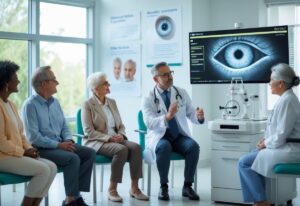How to Prepare for College with Low Vision: Essential Planning Strategies for Academic Success

Preparing your child for college with low vision requires strategic planning and early preparation. The transition from high school to higher education presents unique challenges for students with visual impairments, but with proper support and resources, success is achievable.
Starting early with assistive technology training, disability services coordination, and independence skills development creates the foundation for your child’s college success. Many parents underestimate the time needed to master essential technologies and build the confidence required for independent campus navigation.
At New England Low Vision and Blindness, we work with families to ensure students develop the technical skills and self-advocacy abilities needed for academic achievement. Our assistive technology specialists understand that college preparation extends beyond academics to include daily living skills, technology proficiency, and building strong support networks.
Key Takeaways
- Early preparation with assistive technology and independence skills training is essential for college success
- Connecting with disability services offices and establishing accommodations before enrollment reduces stress and barriers
- Building self-advocacy skills and technology proficiency creates confidence for navigating academic and social challenges
Understanding Low Vision and College Readiness
College readiness for students with visual impairments involves understanding the specific challenges of low vision, recognizing how college differs from high school support systems, and knowing legal rights under federal disability laws.
Definition and Types of Low Vision
Low vision refers to visual impairment that cannot be corrected with standard eyeglasses, contact lenses, or medical treatment. Students with visual impairments experience varying degrees of vision loss that impacts their daily activities and learning.
Common types of low vision include:
| Condition | Description | Impact on Learning |
| Central Vision Loss | Damage to the macula affects detailed vision | Difficulty reading standard print, recognizing faces |
| Peripheral Vision Loss | Loss of side vision | Problems with mobility, spatial awareness |
| Night Blindness | Reduced vision in low light | Challenges with evening classes, dimly lit areas |
| Light Sensitivity | Difficulty with bright lights | Issues with glare from whiteboards, computer screens |
Visually impaired students may have legal blindness (20/200 vision or worse) or functional vision loss that significantly impacts academic tasks. Some students use magnification tools, while others rely on screen readers or braille.
The severity of vision loss varies greatly among students. Some read large print with magnification, while others depend entirely on audio materials or tactile methods.
Differences Between High School and College for Students With Visual Impairments
The transition from high school to college represents a significant shift in responsibility and support systems for students with visual impairments. High school provides structured support through Individualized Education Programs (IEPs) and direct teacher assistance.
Key differences include:
- Self-advocacy responsibility: Students must identify their needs and request accommodations independently
- Resource coordination: No case manager coordinates services; students manage their own support team
- Technology requirements: More complex assistive technology needs for research and coursework
- Independence expectations: Greater emphasis on independent navigation and time management
College disability offices provide accommodations but require students to initiate contact and maintain ongoing communication. Students with visual impairments must develop stronger self-advocacy skills to succeed.
The academic pace increases significantly. Students need efficient note-taking systems and must coordinate with professors for accessible materials in advance.
Legal Rights: ADA, IDEA, and Self-Advocacy
The Americans with Disabilities Act (ADA) protects college students with visual impairments from discrimination and ensures equal access to education. Unlike IDEA, which governs K-12 education, the ADA requires students to self-identify and request accommodations.
Legal framework comparison:
| Law | Coverage | Student Requirements |
| IDEA | K-12 education | Automatic services through IEP |
| ADA | College and beyond | Must request accommodations with documentation |
Students with visual impairments have the right to reasonable accommodations including extended time for exams, alternative format materials, and assistive technology access. Colleges cannot charge fees for these accommodations.
Self-advocacy becomes critical in college. Students must understand their specific needs, communicate effectively with professors, and work with disability services to implement accommodations.
Documentation requirements differ from high school. Students need current medical or psychological evaluations that clearly describe their visual impairment and its impact on academic performance.
The responsibility shifts entirely to the student. No parent or teacher will automatically arrange accommodations or remind students to use available services.
Essential Assistive Technology for College Success
The right assistive technology tools can transform academic performance for students with low vision, while proper integration strategies ensure these technologies enhance rather than complicate the learning process.
Choosing the Right Assistive Tools
Assessment-Based Selection Process We recommend starting with a comprehensive technology assessment that evaluates your child’s specific visual needs and academic requirements. An assistive technology specialist can determine which tools will provide the most benefit.
Consider your child’s current visual acuity, contrast sensitivity, and field of vision limitations. These factors directly influence whether a screen magnifier, refreshable braille display, or combination of tools will work best.
Key Selection Criteria
| Factor | Screen Reader | Screen Magnifier | Braille Display |
| Visual Acuity | Severe vision loss | Moderate vision loss | All levels |
| Learning Style | Auditory preference | Visual preference | Tactile preference |
| Reading Speed | Fast with practice | Variable | Moderate to fast |
| Cost Range | $500-2000 | $200-3000 | $2000-6000 |
Compatibility Requirements Ensure chosen tools work with your child’s college’s learning management system. Most institutions use Canvas, Blackboard, or similar platforms that require specific accessibility features.
Test optical character recognition capabilities for printed materials and textbooks. Many colleges still distribute physical handouts that need digital conversion.
Popular Tech for Students With Low Vision
Screen Reading Solutions JAWS and NVDA represent the most widely used screen reader options for college students. These programs convert text to speech and provide keyboard navigation for computers and mobile devices.
Windows Magnifier offers built-in magnification up to 1600% and works seamlessly with Microsoft Office applications. This free tool provides color inversion and cursor tracking features.
Essential Technology Checklist
- Screen magnification software (ZoomText, MAGic)
- Portable video magnifiers for textbooks
- Refreshable braille display for extended reading
- Voice recording software for lectures
- High-contrast keyboards and mice
Mobile Solutions Smartphones and tablets with built-in accessibility features provide portable magnification and optical character recognition. Voice-to-text applications help with note-taking and assignment completion.
Study Enhancement Tools Digital highlighting and annotation software allows students to mark important text passages. Read-aloud features help with comprehension and retention during study sessions.
Tips for Integrating Technology Into Academic Life
Pre-Semester Preparation Contact the college disability services office at least three months before classes begin. Arrange technology training sessions and software installation on campus computers.
Practice using assistive technology with sample course materials. Familiarity with navigation shortcuts and features reduces learning curve stress during the academic year.
Daily Integration Strategies
| Time Period | Technology Use | Study Tips |
| Before Class | Review materials with screen reader | Use audio recordings for preview |
| During Class | Voice recording + braille notes | Position near power outlets |
| After Class | OCR scanned handouts | Create digital study guides |
Campus Resource Coordination Work with librarians to access digital textbooks and research materials. Many academic databases include built-in accessibility features that complement assistive technology.
Establish backup systems for technology failures. Keep portable magnifiers and voice recorders available when primary systems need repairs or updates.
Time Management With Technology Allow extra time for document conversion and formatting. Optical character recognition processing and screen reader navigation require additional minutes compared to visual reading methods.
Navigating Campus Life and Independence Skills
Developing orientation and mobility skills, connecting with campus support services, and building independent living capabilities form the foundation for college success. These three areas work together to create the confidence and practical skills your child needs to thrive in their new environment.
Orientation and Mobility Strategies
Campus Familiarization Checklist:
- Schedule pre-enrollment campus tours with disability services
- Practice routes between dormitory, dining halls, and classrooms
- Identify key landmarks and reference points for navigation
- Map emergency exits and alternate pathways
Your child should work with an orientation and mobility specialist before starting college. This training provides essential skills for safe campus navigation and builds confidence in unfamiliar environments.
Navigation Tools and Techniques:
| Tool Type | Application | Benefits |
| White cane | Daily mobility | Tactile feedback, obstacle detection |
| Guide dog | Complex navigation | Traffic safety, crowd navigation |
| GPS apps | Route planning | Audio directions, location sharing |
We recommend practicing navigation during different times of day and weather conditions. Campus environments change dramatically between day and night, affecting lighting and pedestrian traffic patterns.
Safety Protocols:
- Always carry emergency contact information
- Share class schedules with trusted contacts
- Practice using campus emergency alert systems
- Identify 24-hour accessible buildings for shelter
Accessing Campus Resources and Support Services
Disability Services Registration Process:
- Submit documentation during the admission process
- Schedule an intake meeting with disability coordinator
- Discuss specific accommodation needs
- Establish communication protocols with professors
- Set up assistive technology training sessions
Connect with vocational rehabilitation services early in the planning process. A vocational rehabilitation counselor can provide funding for assistive technology and training programs that support college success.
Essential Campus Connections:
- Disability Services Office for accommodations
- IT support for technology integration
- Library services for accessible materials
- Academic advisors for course planning
- Counseling services for adjustment support
Accommodation Documentation: Your child should maintain detailed records of all accommodation requests and approvals. This documentation proves essential when working with new professors each semester.
Organizations like the American Foundation for the Blind provide additional resources and advocacy support throughout the college experience. These connections supplement campus-based services and offer specialized guidance.
Transitioning to Independent Living
Daily Living Skills Preparation:
- Personal care and hygiene management
- Meal planning and kitchen safety
- Laundry and clothing organization
- Money management and banking
- Time management and scheduling
Dormitory Setup Strategies:
| Area | Organization Method | Safety Considerations |
| Desk space | Consistent placement of supplies | Adequate lighting for residual vision |
| Closet | Systematic clothing arrangement | Clear pathways, no floor obstacles |
| Bathroom | Labeled personal items | Non-slip surfaces, grab bars |
Practice independent living skills at home before college. Start with weekend independence periods, gradually extending to full weeks without assistance.
Social Integration Approaches:
- Join clubs related to personal interests
- Participate in dormitory activities
- Volunteer for campus organizations
- Attend disability awareness events
Emergency Preparedness: Your child should develop comprehensive emergency plans covering medical situations, technology failures, and natural disasters. Share these plans with roommates and trusted campus contacts.
Building independence requires patience and practice. We work with families to identify specific skill gaps and develop targeted training programs that address individual needs and college requirements.
Building Academic and Personal Success
Establishing strong academic foundations and personal connections creates the framework for college success. Developing specialized study techniques, maintaining clear faculty communication, and utilizing disability services ensure visually impaired students thrive in higher education environments.
Study Techniques for Visually Impaired College Students
Audio-Based Learning Methods
- Record lectures with professor permission
- Use text-to-speech software for reading assignments
- Create audio study notes and summaries
- Listen to audiobooks when available
Digital Organization Systems
- Organize files in clearly labeled folders
- Use consistent naming conventions for documents
- Create digital study schedules with reminder alerts
- Maintain backup copies of all academic materials
Time Management Strategies
| Technique | Implementation | Benefits |
| Task chunking | Break large assignments into 30-minute segments | Reduces overwhelm, increases focus |
| Priority matrix | Rank tasks by urgency and importance | Ensures critical deadlines are met |
| Buffer time | Add 20% extra time to estimated task duration | Accommodates unexpected challenges |
Memory Enhancement Techniques
- Use mnemonic devices for complex information
- Create concept maps using accessible software
- Practice active recall through self-testing
- Form study groups for collaborative learning
Developing Effective Communication With Faculty
Initial Contact Protocol Meet with professors during the first week of classes. Introduce yourself and explain your visual needs without requesting specific accommodations initially. This builds rapport before discussing formal adjustments.
Professional Communication Standards
- Use clear, concise language in emails
- Respond to faculty communications within 24-48 hours
- Schedule regular office hours meetings
- Maintain professional tone in all interactions
Accommodation Discussions
| Discussion Point | Approach | Expected Outcome |
| Extended time | “I process written material through screen readers” | Additional exam time |
| Alternative formats | “I work most efficiently with digital materials” | Electronic textbooks, handouts |
| Seating preferences | “I benefit from front row positioning” | Reserved classroom seating |
Building Long-term Relationships Faculty relationships extend beyond individual courses. Professors often provide research opportunities, recommendation letters, and career guidance. Maintain connections through periodic updates and genuine interest in their work.
Connecting With Disability Services and Advocacy Groups
Disability Services Office Engagement Register with your college’s disability services office before classes begin. Submit documentation early and schedule intake appointments during summer orientation periods.
Documentation Requirements Checklist
- Current eye examination reports
- Functional vision assessments
- Previous IEP or 504 plan documentation
- Assistive technology needs assessment
- Academic accommodation history
Peer Support Networks
Students benefit significantly from connections with other visually impaired college
Frequently Asked Questions
College planning for students with low vision involves understanding accommodations, technology options, and support services available at different institutions. Students must also learn qualification processes and effective study methods for academic success.
What accommodations can be made for visually impaired students in college?
Colleges provide extended time for exams and assignments as a standard accommodation. Students can receive materials in alternative formats, including large print, braille, or electronic text.
Classroom accommodations include preferential seating near the front and access to lecture recordings. Note-taking services connect students with peer note-takers or professional scribes.
Testing accommodations allow separate quiet rooms with specialized equipment. Students can use screen readers, magnification software, or braille displays during exams.
Physical accommodations include mobility training for campus navigation. Colleges also provide tactile maps and accessible dormitory rooms with proper lighting.
Which colleges are known for providing the best support for blind or low vision students?
Research each college’s disability services office individually since support quality varies significantly between institutions. Schedule appointments with disability services staff during campus visits to evaluate their resources directly.
Look for colleges with dedicated assistive technology labs and trained support staff. The best programs offer comprehensive orientation programs specifically designed for students with visual impairments.
Contact current students or alumni with similar visual conditions through disability services offices. Their firsthand experiences provide valuable insights into daily campus life and available support.
What are some effective study strategies for college students with low vision?
Digital textbooks work better than physical books for most students with low vision. Request electronic formats from publishers or disability services offices early in each semester.
Audio recording lectures helps reinforce visual information missed during class. Many professors provide lecture recordings through learning management systems.
Break study sessions into shorter periods to reduce eye strain and fatigue. Use task lighting and adjust computer screen settings for optimal contrast and font size.
Form study groups with classmates to share notes and discuss complex concepts. Collaborative learning fills gaps that may occur from visual information processing challenges.
How does a low vision student qualify for disability services in college?
Submit documentation from an eye care professional that includes your specific visual condition and functional limitations. The documentation must be current, typically within three years.
Complete the disability services registration process during summer orientation or early in your first semester. Each college has different paperwork requirements and deadlines.
Meet with disability services staff to discuss your specific accommodation needs. This conversation determines which services and equipment will be available to you.
Students maintain responsibility for requesting and coordinating their accommodations throughout college. Disability services staff provide guidance but students must advocate for their needs.
In what ways can technology aid students with low vision in a college setting?
Screen magnification software enlarges text and graphics on computer screens up to 60 times normal size. Students can adjust magnification levels for different tasks and applications.
Text-to-speech software reads digital content aloud while highlighting words on screen. This technology works with textbooks, web pages, and document files.
Portable video magnifiers help students read printed materials that aren’t available digitally. These devices can magnify text, enhance contrast, and change color combinations.
Smartphone apps provide additional support for daily college tasks. OCR apps convert printed text to speech while navigation apps provide audio directions around campus.
Can low vision be considered a learning disability in the context of higher education?
Low vision qualifies as a disability under the Americans with Disabilities Act but differs from specific learning disabilities. Visual impairments affect how information is received rather than how the brain processes information.
Colleges recognize low vision as a qualifying condition for disability services and accommodations. Students receive support based on functional limitations rather than disability categories.
Some students may have both visual impairments and learning disabilities requiring different types of support. Disability services offices coordinate accommodations for multiple conditions when necessary.
The qualification process focuses on how your visual condition impacts academic performance. Documentation must demonstrate the connection between your vision loss and need for specific accommodations.
You’re Not Alone — We’re Here to Help Your Family Take the Next Step
Our caring specialists at New England Low Vision and Blindness are here to help you and your family take the next steps with confidence. Schedule a Free Consultation or Contact Us today to learn how early intervention and the right assistive technology can empower your child to thrive.



